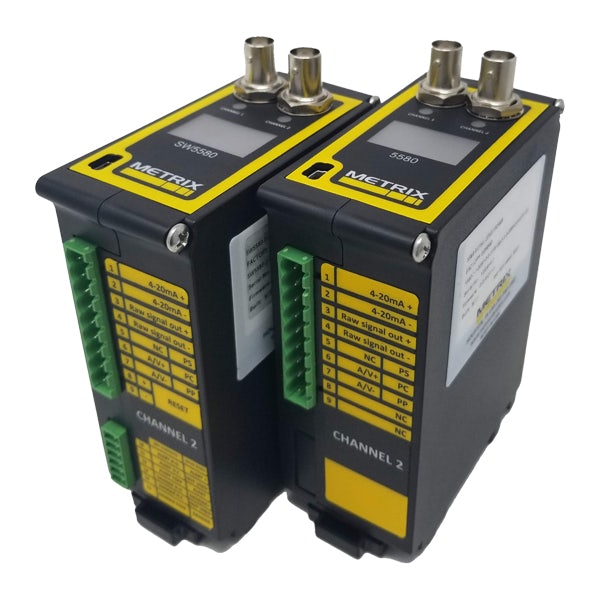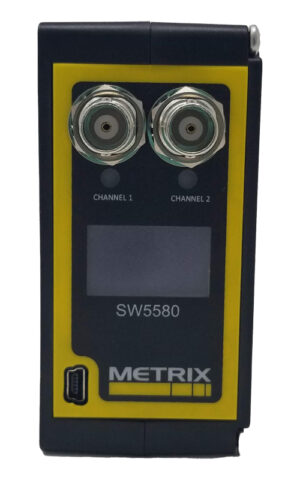Metrix SW5580 & 5580
Dual channel configurable switch and vibration signal conditioner
The Metrix SW5580 is a 2-channel configurable switch and vibration signal conditioner for rotating machinery. The compact transmitter-based system is DIN-rail mounted and designed to convert raw vibration signals from accelerometers, velocity or proximity sensors to a 4-20 mA output. The SW5580 offers users extensive configurability options, including relay contacts, to fit a wide range of applications.
Note: the 5580 series is available in two versions; the SW5580 has two relay contacts for alarm functions, which the 5580 does not have. There are no further differences.
Benefits
Configurable relay contacts
The SW5580 comes with two optional relays, that can be configured for alarm level and time delay. These relays can be ordered with solid state or dry contacts.
Fully configurable 2-channel device
The SW5580 comes with two channels, which are independently fully configurable to your specific application. The exact configurations can be pre-ordered or configured after ordering with Metrix software.
Internal signal conditioning
The SW5580 offers internal signal conditioning for further travel distances of the raw signal to e.g., a monitoring system.
Design
The Metrix SW5580 is a transmitter-based system and is DIN-rail mounted. It has a mini-USB interface for quick and easy configuration via PC. It comes with free software to configure the device to meet application-specific requirements. The SW5580 can either be used as single-channel (single sensor with up to two signal conditioning outputs) or dual-channel solution (two sensors with one signal conditioning output each). The 4-20 mA output allows the signal to be sent to a distance of up to 2 KM to a DCS, PLC or SCADA.
The SW5580 comes with additional relay contacts, which the 5580 does not include. The SW5580 can be ordered with either solid state or dry relay contacts, which can be configured for alarm level and time delay.

How it works
This video provides a detailed description of the operation, possible measurements and connections of the SW5580 and 5580. For questions, please contact one of our specialists »

Applications
The Metrix SW5580 is suitable for rotating equipment and reciprocating machinery, such as:
■ Centrifugal compressors
■ Motors and pumps
■ Industrial fans
■ Reciprocating compressors
■ Generators
■ Centrifuges
■ Natural gas / diesel engines
■ Turbines
Features
Any sensor type
The SW5580 accepts signals from machine casing mounted velocity sensors, accelerometers or shaft observing proximity probes. It produces a raw signal for local analysis, and a 4-20 mA output signal.
Transmitter-based solution
The SW5580 is a compact DIN-rail mounted transmitter, which offers both economic and technical advantages over traditional rack-based solutions.
Sensor and cable integrity
The SW5580 indicates the sensor and cable integrity with a green LED. Sensor failures will be detected when the output current is driven below 3.6 mA, which changes the LED to red.
System features
- 4-20 mA output proportional to the vibration level
- Drives dynamic signals over long ranges (300m)
- LED for sensor and cable status, and alarm levels (SW5580 only)
- Field configurable using free Metrix software
- BNC connector for waveform analyzers
Possible measurements
- Shaft-relative radial vibration
- Shaft axial position
- Casing vibration (radial or axial)
- Shaft rotational speed
- Rod drop and rod position (reciprocating compressor)
- Crosshead acceleration (reciprocating compressor)
- Impact measurements (reciprocating compressor)
- Frame vibration (reciprocating compressor)
- Dual path measurements
- Dual channel measurements
6 common causes of machine vibrations
Excessive vibrations on rotating equipment like pumps, gearboxes, turbines and compressors are a clear sign that the equipment is not functioning properly. Equipment that is showing excessive vibrations will most…
Sensor solutions for vibration measurements
Selecting the right sensor for the application is crucial for measuring machine vibration. The sensor signal is the input for the protection or monitoring system. A false sensor leads to…
8 effects of machine vibrations
Monitoring machine vibrations affords greater control over the safety and availability of the equipment. It reduces unscheduled downtime and potential damage or failure can be resolved at an early stage.…
